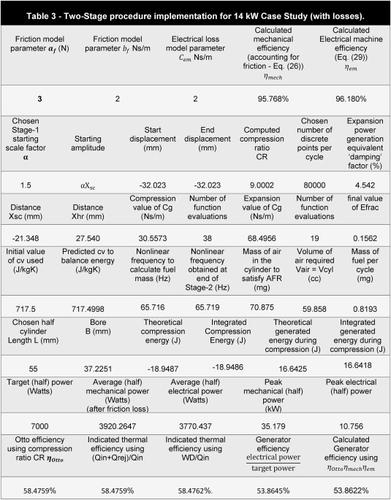当前位置:
X-MOL 学术
›
Int. J. Hydrogen Energy
›
论文详情
Our official English website, www.x-mol.net, welcomes your feedback! (Note: you will need to create a separate account there.)
A numerical procedure to obtain ideal piston trajectories and key design parameters for a hydrogen-fuelled resonating free piston generator
International Journal of Hydrogen Energy ( IF 7.2 ) Pub Date : 2024-03-21 , DOI: 10.1016/j.ijhydene.2024.03.187 J.F. Dunne
International Journal of Hydrogen Energy ( IF 7.2 ) Pub Date : 2024-03-21 , DOI: 10.1016/j.ijhydene.2024.03.187 J.F. Dunne

|
A new numerical procedure is presented to enable a hydrogen-fuelled two-stroke resonating free-piston generator target ideal Otto cycles to provide tracking paths for feedback control to maximise efficiency. Piston trajectories and design parameters are obtained for specified power, compression-ratio, and air-fuel-ratio. These parameters include scavenge port locations, heat release position, equivalent bottom-dead-centre position, and an electrical machine constant which is generally power-switched to take two values within a cycle. The main objectives of the paper are to develop the numerical procedure, and to demonstrate its use in finding a generator with maximum efficiency, and a generator with a single electrical machine constant, avoiding in-cycle power switching. To develop the procedure, a multi-physics generator model provides kinematics to an energy equation, culminating in a novel two-stage procedure. Stage-1 involves iteration and minimisation; Stage-2 just involves minimisation. Testing by simulation involves a 14-kW generator case study with compression ratio of 9, lean air-fuel equivalence ratio of 0.4, plus friction and electrical machine losses. An overall maximum generator efficiency of 54.9% is obtained using the procedure, compared to 51.3% without power switching. Computationally, the two-stage procedure proves highly efficient, typically taking around 11 min in total to complete on a desktop computer. The novelty of the procedure is its ability to optimally design and operate a hydrogen-fuelled resonating free-piston generator to meet a target specification, thereby offering a potentially inexpensive way to decarbonize transport, particularly in heavy duty applications.
中文翻译:

获得氢燃料谐振自由活塞发电机理想活塞轨迹和关键设计参数的数值程序
提出了一种新的数值程序,使氢燃料二冲程谐振自由活塞发电机能够以理想的奥托循环为目标,为反馈控制提供跟踪路径,从而最大限度地提高效率。获得指定功率、压缩比和空燃比的活塞轨迹和设计参数。这些参数包括扫气口位置、热释放位置、等效下止点位置以及电机常数,该电机常数通常通过电源切换以在一个周期内取两个值。本文的主要目标是开发数值程序,并展示其在寻找具有最高效率的发电机以及具有单个电机常数的发电机中的用途,从而避免循环功率切换。为了开发该程序,多物理场发生器模型为能量方程提供了运动学,最终形成了一种新颖的两阶段程序。第一阶段涉及迭代和最小化;第二阶段只涉及最小化。模拟测试涉及 14 kW 发电机案例研究,压缩比为 9,贫空燃当量比为 0.4,加上摩擦和电机损耗。使用该程序获得的总体最大发电机效率为 54.9%,而没有电源切换时为 51.3%。从计算角度来看,两阶段过程非常高效,在台式计算机上通常总共需要大约 11 分钟才能完成。该程序的新颖之处在于它能够优化设计和操作氢燃料谐振自由活塞发电机以满足目标规格,从而提供一种潜在的廉价方式来使运输脱碳,特别是在重型应用中。
更新日期:2024-03-21
中文翻译:

获得氢燃料谐振自由活塞发电机理想活塞轨迹和关键设计参数的数值程序
提出了一种新的数值程序,使氢燃料二冲程谐振自由活塞发电机能够以理想的奥托循环为目标,为反馈控制提供跟踪路径,从而最大限度地提高效率。获得指定功率、压缩比和空燃比的活塞轨迹和设计参数。这些参数包括扫气口位置、热释放位置、等效下止点位置以及电机常数,该电机常数通常通过电源切换以在一个周期内取两个值。本文的主要目标是开发数值程序,并展示其在寻找具有最高效率的发电机以及具有单个电机常数的发电机中的用途,从而避免循环功率切换。为了开发该程序,多物理场发生器模型为能量方程提供了运动学,最终形成了一种新颖的两阶段程序。第一阶段涉及迭代和最小化;第二阶段只涉及最小化。模拟测试涉及 14 kW 发电机案例研究,压缩比为 9,贫空燃当量比为 0.4,加上摩擦和电机损耗。使用该程序获得的总体最大发电机效率为 54.9%,而没有电源切换时为 51.3%。从计算角度来看,两阶段过程非常高效,在台式计算机上通常总共需要大约 11 分钟才能完成。该程序的新颖之处在于它能够优化设计和操作氢燃料谐振自由活塞发电机以满足目标规格,从而提供一种潜在的廉价方式来使运输脱碳,特别是在重型应用中。



























 京公网安备 11010802027423号
京公网安备 11010802027423号